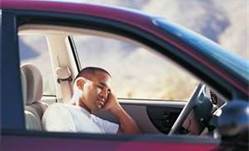The Top Things Drivers Do to 'Fight the Drowse' -- Do Not Work
 |
DAYTONA BEACH, FL -- June 25, 2014: With the summer road-trip season hitting high gear July 4th,, and in the wake of a deadly crash, allegedly caused by drowsy-driving, that critically injured comedian Tracy Morgan, DMEautomotive (DMEa) recently surveyed American drivers on the top ways they try to combat sleepiness on the road.
The results are a wake-up call: While the #1 method, drinking caffeinated beverages, can be a temporary, yet not fully effective fix, drivers report they're more likely to open windows, pull over and exercise/stretch, blast loud music and the air conditioning (which studies indicate have very short-term to no effect), than do what safety experts recommend most: pull over and take a nap. Pulling over and napping (only 23% reporting) ranked a lowly 7th, on a par with eating or singing (21%). The findings indicate most drivers are doing things to fight sleepiness-at-the-wheel that don't work, and it's likely contributing to the scary statistics: drowsy driving is responsible for somewhere between 15-33% of all fatal crashes,1 or more than 100,000 accidents each year.2
The DMEa survey of 2,000 car owners3 also found that a lot of drowsy drivers may be out on the roads these next months. The majority (53%) of U.S. drivers reported that they are taking a road trip this summer, and that they plan to drive at least 7 hours each day – with 1 in 10 reporting they plan to drive more than 12 hours.
"The recent crash involving Tracy Morgan was tragic, and draws attention to an incredibly dangerous driving behavior that doesn't get taken nearly as seriously as drinking or texting while driving," said Mary Sheridan, Director of Research and Analytics for DMEautomotive. "This survey reveals a big problem: when people get sleepy on the road, too many take measures that simply don't work. Most of us do ineffective things like stopping for that third triple-shot cappuccino or slapping water on our face just to keep going. As drivers, we need to heed our drowsiness: and stop and sleep, or let a rested person drive."
Notably, among the top 15 things drivers do to fight drowsiness, only #3 (switching drivers, provided they're rested) and #7 (pulling over and napping), are supported as working by medical evidence and safety experts. For the #1 method, drinking caffeine, the expert consensus is that while it does temporarily boost driver alertness, it's no replacement for sleep.
Younger Drivers Far Less Likely to Stop for Naps – Far More Likely to Sing, Eat, Blast Music & Talk on Phone:
| 1 | Drink A Caffeinated Beverage | 58.70% |
| 2 | Switch Drivers |
44.50% |
| 3 | Listen to Loud Music | 42.50% |
| 4 | Open a Window or Sun Roof | 39.30% |
| 5 | Eat | 33.00% |
| 6 | Sing | 31.70% |
| 7 | Turn Up the A/C |
29.20% |
| 8 | Pull Over and Exercise/Stretch | 26.60% |
| 9 | Pull Over and Nap |
19.00% |
| 10 | Talk to Self | 15.40% |
| 11 | Slap Yourself | 13.10% |
| 12 | Listen to Talk Radio | 12.20% |
| 13 | Exercise or Stretch in the Car | 12.10% |
| 14 | Smoke | 11.80% |
| 15 | Splash Water on Your Face or Neck | 9.00% |
What Medical Studies/Safety Experts Say Works, and Doesn't:
DMEa aggregated authoritative and available medical evidence on which "fight the drowse" strategies work, and which don't (hint: most don't, and a good night's sleep is the best preventative!).
Drinking caffeine: Caffeine can be an effective, if temporary, drowsy-driving fighter, but should not replace sleep. Caffeine doesn't overcome the effects of drowsy driving: for instance, you can still experience "micro-sleeps," falling asleep for a few seconds unconsciously. And because caffeine doesn't enter the bloodstream for 30 minutes, scientists recommend the "caffeine nap": taking a 30-minute nap first, then drinking the equivalent of 1-2 cups of strong coffee.
Opening window/sunroof: No evidence of benefit.
Switching drivers: Effective, if new driver is rested.
Pulling over to exercise/stretch: Contrary to what many people may imagine, offers very little benefit. Exercise only provides a very temporary alertness-effect (only lasting 10-15 minutes) in studies.
Loud music: No benefit, and can serve to distract drivers from their drowsiness.
Turning up AC: No real benefit.
Napping: Studies have shown naps between 20 minutes - 3 hours prevent fatigue and restore alertness. Experts recommend scheduling a driving break every 2 hours, and napping. Napping is, however, not a substitute for longer sleep, and getting at least 7 hours sleep before a long drive is critical. Drivers' main sleep periods should happen at night, driving between midnight and 6AM should be avoided, as should rotating night and day duty.
The Consensus: Just stop driving if you're sleepy, and the only real recovery strategy is sleep.
Sources: AAA report from Univ. of Pennsylvania (review of medical studies, including Horne and Reyner's, Horne and Foster's), AARP, NHTSA, UCLA Health Sleep Disorders Center, University of Maryland Medical Center


